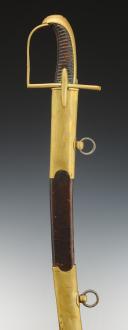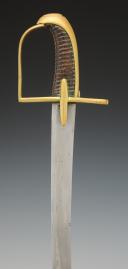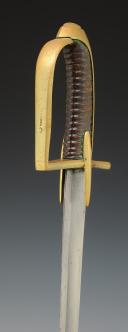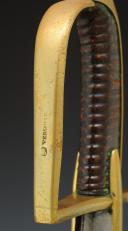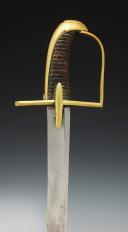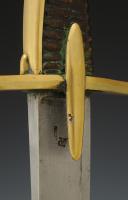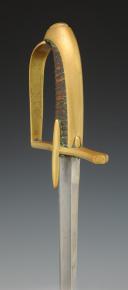
Hussar Sabre of the 4th Regiment, An IX model, from the Revolutionary - Consulate period. 29915
Sold out
Hussar Sabre of the 4th Regiment, An IX model, from the Revolutionary - Consulate period. 29915
Brass hilt. Guard with a single branch, stamped with a rooster (a stamp used for revolutionary productions from 1793 onwards) and signed "VERSAILLES," with the "B" stamp of J.J.C. Bureau, director from February 1812 to July 1813. Long-tailed cap. Handle made of calf leather-covered wood. Curved blade with hollow edges, stamped with the bundle of rods and the "AP" stamp from the Paris workshop, length 86.1 cm. Wooden scabbard covered with black waxed leather, with two large brass fittings with iron staples, iron rings, and a matching tip.
France. Revolutionary - Consulate period.
Very good condition.
NOTE:
This particular piece has a quillon terminating in a hollow cutout rather than the typical button, indicating that it was part of an order of fewer than 400 units placed with the Versailles Manufacture.
In his seminal work "Les sabres de Hussards de Louis XIV à nos jours" (The Hussar Sabers from Louis XIV to Nowadays), Michel Pétard wrote regarding this production:
"THE SPECIAL MODEL OF THE COLONEL-GENERAL REGIMENT, KNOWN AS OF 1780:
This regiment, established on August 22, 1779, but organized three years later on July 31, 1783, was formed from a squadron taken from each of the four existing regiments. Instituted by Louis XVI in favor of the Duke of Chartres, who would later become the Duke of Orléans in 1785, this position of Colonel-General of the Hussars implied the creation of a regiment under this title and the official recognition of the hussars as a military branch. In 1783, a distinctive uniform was assigned to the new regiment, as well as a unique type of saber that deliberately stood out from the general armament of the hussars. Although no archival document informs us of its genesis, a specimen model was preserved thanks to Gribeauval's initiative to establish an artillery museum intended for the instruction of officer cadets, which reserved any model manufactured at Klingenthal for this purpose. This model, of which we know rare examples, left a trace in the form of a supplementary order for the regiment dated December 1786, of which 321 units were delivered between September 16, 1786, and May 23, 1787."
HISTORICAL BACKGROUND:
The Colonel-General Hussars regiment was a French cavalry regiment of the Ancien Régime founded in 1779, later becoming the 4th regiment of hussars during the Revolution.
Establishment and various denominations:
August 22, 1779: Creation of the Colonel-General of Hussars position.
July 31, 1783: Formation of the Colonel-General Hussars regiment by merging the 1st squadron of Berchény, the 2nd squadron of Chamborant, and the 3rd squadron of Esterhazy.
March 17, 1788: Strengthened by a 4th squadron composed of men selected from the cavalry regiments of Quercy, Septimanie, Nassau, La Marche, Franche-Comté, and the Évêchés.
January 1, 1791: Renamed the 5th Regiment of Hussars.
June 4, 1793: Renamed the 4th Regiment of Hussars.
1814: Renamed the Hussars of Monsieur regiment.
1815: Renamed the 4th Regiment of Hussars.
1815: Disbanded.
Campaigns and battles:
The 5th Regiment of Hussars, later the 4th Regiment of Hussars following the emigration of the Saxe Hussars regiment on May 4, 1792, participated in campaigns from 1792 to 1794 in the Army of the North.
The 4th Regiment of Hussars took part in campaigns during years IV and V in the Army of Sambre-et-Meuse; year VI in the Army of Germany and the Army of Mayence; year VII in the Armies of Mayence and the Danube; years VIII and IX in the Army of the Rhine. Notable battles include the Battle of Neuwield on April 18, 1797; the Battle of Stockach on March 25, 1797; the crossing of the Alb, the Battle of Hochstedt, and the crossing of the Danube on April 29, June 19, and June 22, 1800.
The regiment participated in campaigns from year XI to year XIV in Hanover; in 1806 and 1807 in the 1st corps of the Grande Armée; from 1809 to 1810 in the Army of Spain; 1811 in the Armies of Spain and Aragon; 1812 in the Army of Aragon and the 3rd Corps of the Grande Armée; 1814 in the Army of Lyon (6th Corps of the Grande Armée); and in 1815 in the 7th Army Corps.
Upon the first Restoration, the 4th Regiment of Hussars took the title of the Hussars of Monsieur regiment, incorporating remnants of the 14th Regiment of Hussars into its ranks.
Brass hilt. Guard with a single branch, stamped with a rooster (a stamp used for revolutionary productions from 1793 onwards) and signed "VERSAILLES," with the "B" stamp of J.J.C. Bureau, director from February 1812 to July 1813. Long-tailed cap. Handle made of calf leather-covered wood. Curved blade with hollow edges, stamped with the bundle of rods and the "AP" stamp from the Paris workshop, length 86.1 cm. Wooden scabbard covered with black waxed leather, with two large brass fittings with iron staples, iron rings, and a matching tip.
France. Revolutionary - Consulate period.
Very good condition.
NOTE:
This particular piece has a quillon terminating in a hollow cutout rather than the typical button, indicating that it was part of an order of fewer than 400 units placed with the Versailles Manufacture.
In his seminal work "Les sabres de Hussards de Louis XIV à nos jours" (The Hussar Sabers from Louis XIV to Nowadays), Michel Pétard wrote regarding this production:
"THE SPECIAL MODEL OF THE COLONEL-GENERAL REGIMENT, KNOWN AS OF 1780:
This regiment, established on August 22, 1779, but organized three years later on July 31, 1783, was formed from a squadron taken from each of the four existing regiments. Instituted by Louis XVI in favor of the Duke of Chartres, who would later become the Duke of Orléans in 1785, this position of Colonel-General of the Hussars implied the creation of a regiment under this title and the official recognition of the hussars as a military branch. In 1783, a distinctive uniform was assigned to the new regiment, as well as a unique type of saber that deliberately stood out from the general armament of the hussars. Although no archival document informs us of its genesis, a specimen model was preserved thanks to Gribeauval's initiative to establish an artillery museum intended for the instruction of officer cadets, which reserved any model manufactured at Klingenthal for this purpose. This model, of which we know rare examples, left a trace in the form of a supplementary order for the regiment dated December 1786, of which 321 units were delivered between September 16, 1786, and May 23, 1787."
HISTORICAL BACKGROUND:
The Colonel-General Hussars regiment was a French cavalry regiment of the Ancien Régime founded in 1779, later becoming the 4th regiment of hussars during the Revolution.
Establishment and various denominations:
August 22, 1779: Creation of the Colonel-General of Hussars position.
July 31, 1783: Formation of the Colonel-General Hussars regiment by merging the 1st squadron of Berchény, the 2nd squadron of Chamborant, and the 3rd squadron of Esterhazy.
March 17, 1788: Strengthened by a 4th squadron composed of men selected from the cavalry regiments of Quercy, Septimanie, Nassau, La Marche, Franche-Comté, and the Évêchés.
January 1, 1791: Renamed the 5th Regiment of Hussars.
June 4, 1793: Renamed the 4th Regiment of Hussars.
1814: Renamed the Hussars of Monsieur regiment.
1815: Renamed the 4th Regiment of Hussars.
1815: Disbanded.
Campaigns and battles:
The 5th Regiment of Hussars, later the 4th Regiment of Hussars following the emigration of the Saxe Hussars regiment on May 4, 1792, participated in campaigns from 1792 to 1794 in the Army of the North.
The 4th Regiment of Hussars took part in campaigns during years IV and V in the Army of Sambre-et-Meuse; year VI in the Army of Germany and the Army of Mayence; year VII in the Armies of Mayence and the Danube; years VIII and IX in the Army of the Rhine. Notable battles include the Battle of Neuwield on April 18, 1797; the Battle of Stockach on March 25, 1797; the crossing of the Alb, the Battle of Hochstedt, and the crossing of the Danube on April 29, June 19, and June 22, 1800.
The regiment participated in campaigns from year XI to year XIV in Hanover; in 1806 and 1807 in the 1st corps of the Grande Armée; from 1809 to 1810 in the Army of Spain; 1811 in the Armies of Spain and Aragon; 1812 in the Army of Aragon and the 3rd Corps of the Grande Armée; 1814 in the Army of Lyon (6th Corps of the Grande Armée); and in 1815 in the 7th Army Corps.
Upon the first Restoration, the 4th Regiment of Hussars took the title of the Hussars of Monsieur regiment, incorporating remnants of the 14th Regiment of Hussars into its ranks.
Reference :
29915
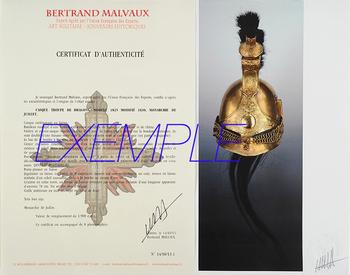
Next update Friday, april 25th at 13:30 PM
FOR ALL PURCHASES, PAYMENT IN MULTIPLE CHECKS POSSIBLE
bertrand.malvaux@wanadoo.fr 06 07 75 74 63
An authenticity certificate of the item including the description published on the site, the period, the sale price, accompanied by one or more color photographs is automatically provided for any item priced over 130 euros. Below this price, each certificate is charged 5 euros.
Only items sold by me are subject to an authenticity certificate, I do not provide any expert reports for items sold by third parties (colleagues or collectors).
